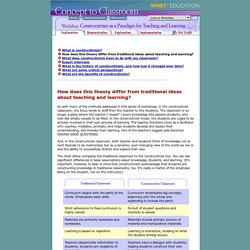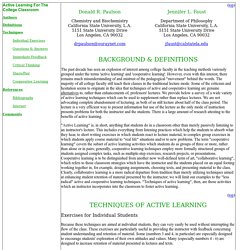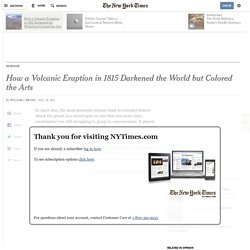

Constructivism as a Paradigm for Teaching and Learning. What is constructivism?

How does this theory differ from traditional ideas about teaching and learning? What does constructivism have to do with my classroom? Expert interview What is the history of constructivism, and how has it changed over time? What are some critical perspectives? What are the benefits of constructivism? How does this theory differ from traditional ideas about teaching and learning? As with many of the methods addressed in this series of workshops, in the constructivist classroom, the focus tends to shift from the teacher to the students.
Active and Coopeative Learning. The past decade has seen an explosion of interest among college faculty in the teaching methods variously grouped under the terms 'active learning' and 'cooperative learning'.

However, even with this interest, there remains much misunderstanding of and mistrust of the pedagogical "movement" behind the words. The majority of all college faculty still teach their classes in the traditional lecture mode. Some of the criticism and hesitation seems to originate in the idea that techniques of active and cooperative learning are genuine alternatives to, rather than enhancements of, professors' lectures. We provide below a survey of a wide variety of active learning techniques which can be used to supplement rather than replace lectures.
We are not advocating complete abandonment of lecturing, as both of us still lecture about half of the class period. "Active Learning" is, in short, anything that students do in a classroom other than merely passively listening to an instructor's lecture. Cognitive Load Theory - Learning Skills From MindTools.com. © iStockphotorweisswald Don't overload your brain when you want to learn better.
Have you ever been on a course where the trainer went through his material so quickly that you barely learned a thing? Or maybe the content was so complex that it went completely over your head? In this article, we'll look at Cognitive Load Theory (CLT). This takes a scientific approach to the design of learning materials, so that they present information at a pace and at a level of complexity that the learner can fully understand. How Do We Process Information? Cognitive Load Theory builds upon the widely accepted model of human information processing shown in figure 1 (this was published by Richard Atkinson and Richard Shiffrin in 1968.)
It describes the process as having three main parts: sensory memory, working memory and long-term memory. Figure 1: Information Processing Model Adapted from Atkinson, R.C. and Shiffrin, R.M. (1968). Every day, you are bombarded with sensory information. 1. 2. 3. 4. Key Points.
Studentreasures. Create a Book With Your Class!

Make teaching writing easy and funBuild students’ pride, self-esteem and confidenceMotivate students to want to writeSpark creativity through hands-on learning It’s the perfect activity for any class, any subject! Plus, your automatically entered to win a thousands of dollars in school grants when you publish by November 30th, 2015! Publishing is easy! ORDER your FREE kits and choose your publishing dateGET CREATIVE! View a sample book. Easy, adaptable kits Our publishing kits are perfect for turning any lesson into a hardbound book to showcase your students’ work! How a Volcanic Eruption in 1815 Darkened the World but Colored the Arts. Photo In April 1815, the most powerful volcanic blast in recorded history shook the planet in a catastrophe so vast that 200 years later, investigators are still struggling to grasp its repercussions.

It played a role, they now understand, in icy weather, agricultural collapse and global pandemics — and even gave rise to celebrated monsters. Around the lush isles of the Dutch East Indies — modern-day Indonesia — the eruption of Mount Tambora killed tens of thousands of people. They were burned alive or killed by flying rocks, or they died later of starvation because the heavy ash smothered crops. More surprising, investigators have found that the giant cloud of minuscule particles spread around the globe, blocked sunlight and produced three years of planetary cooling. “The year without a summer,” as 1816 came to be known, gave birth not only to paintings of fiery sunsets and tempestuous skies but two genres of gothic fiction. “The paper trail,” said Dr. “The modern world,” Dr. Dr. Dr. Does Your Classroom Tell a Story? Do you have mystery objects that attract the curiosity of students, leading them to ask questions that foster meaningful conversations?

Is your classroom visually stimulating for the students? Does it cultivate creativity, and more importantly, is it filled with objects, images, and even props that help your students learn -- even when they think they're not learning? Like most teachers, I decorate my classroom with posters and objects that help promote learning, but that also lend a little pizzazz to an otherwise humdrum learning environment. It is typical, for example, for science teachers to have full skeletons and periodic tables in the classrooms, or for history teachers to have maps and portraits of famous historical figures pinned to the walls. However, the best teaching props are the ones that are not so obvious and that help the teacher reach students in unexpected ways. Reading Writing and Rising Up - Rethinking Schools Online.